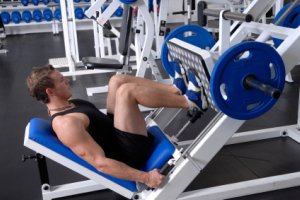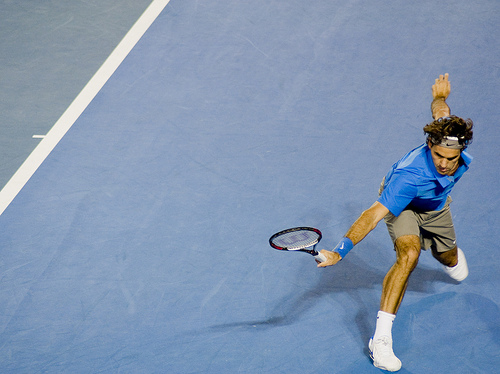Tennis training workouts start with the physical component of tennis first, as this is a factor that is often lacking in non professional players. A tennis training workout focuses on the fitness element of the game, so players can develop their endurance, explosiveness and versatility on the tennis court.
The idea of tennis training workouts are typically unheard of at the club level of tennis and this type of tennis training is usually reserved for advanced tennis players. Beyond the beginner level, however is the small factors (tennis training workouts) that separate good players from average players.
If you’re a competitive tennis player, you are always looking for ways to improve. Practicing and improving your strokes is one way to get better. For many players, though, not much attention is paid to their physical conditioning.
The Reason For Doing Tennis Training Workouts
Tennis has become quite demanding on the body so much so that specific tennis training workouts have been designed. Sure, there are still some senior players at the club level who can beat younger and faster players by the quality of their shots, their intelligence in constructing points and their mental toughness.
But at higher levels, the fitter players always have an advantage. At the professional level, the best players in the world are also some of the best athletes in all of sports.
Each person has different anatomic and physiologic characteristics. There are certain areas that one person may need to pay attention to more than others. Some may need to focus more on diet and weight loss while others may need more strength or flexibility. To design a perfect tennis training workout for a specific player, he or she needs to identify the exact areas which need improvement most.
There are, however, some general principles that serve as guidelines for designing a workout plan and these are based on the components of fitness which are strength, flexibility, speed, agility and stamina.
Tennis Training Workouts: Strength Training for Tennis
Strength training for tennis players is now standard for pros ever since the successes of players like Ivan Lendl and Martina Navratilova. Strength increases the power of your shots and minimizes injuries by protecting the joints that are subject to repetitive stress.
A tennis training workout for improving strength makes use of free weights, resistance bands and cable machines. Additionally, core exercises and plyometric exercises are also incorporated. It is of the essence that the entire body be worked out from ground up.
Tennis Training Workouts: Lower Body Tennis Training


Therefore, strong legs provide and advantage not just for speed but also for better stroking mechanics.
For the lower body, tennis training workouts should include free weight regular squats, split squats, lunges and calf raises.
Alternatively, machine leg presses and calf exercises can be done. The usual recommendation is to do each type of exercise in three sets of 15 repetitions each.
For a stronger core, abdominal exercises and lower back exercises should be done. The standard sit-up can be performed on the floor or on a stability ball. The obliques should also be exercised with twisting crunches. This is because the serve and the ground strokes require trunk twisting movements.
Tennis Training Workouts: Lower Back and Upper Body Exercises
Superman Exercise
For the lower back, back extensions or the “Superman” exercise can be done. The “Superman” exercise is performed while lying face down on the floor. The legs and arms are raised off the floor and held for a few counts then lowered and raised again. These exercises should be performed in 3 sets of 15-20 reps each.
Russian Twist
Another core exercise is the standing Russian twist. This makes use of a medicine ball which is held out in front of the chest at arm’s length. You twist to the left and back to the centre 10 times, and then repeat for the right side. Again, 3 sets are recommended.
For the upper body part of the tennis training workout, bench presses or push ups are good for the chest and shoulders. One-armed bent-over rows or cable machine pulls are good for the upper back. The shoulder is the first critical joint that needs strengthening because it is quite prone to develop repetitive stress injuries. Shoulder presses, lateral raises and forward raises can all be performed.
Tennis Training Workouts: Rotator Cuff Exercises
The rotator cuff should be strengthened as well. Exercises for this include external rotations of which there are several kinds. They can be done standing up with the arm free from the body, seated with the arm supported by the knee or lying on one side with the arm resting on a towel placed on the side of the torso.
Each of these exercises is done 15 times for 3 sets. It is imperative that not only the playing arm and shoulder be worked out but also the non-dominant side. Uneven muscular development makes the body prone to develop postural problems which can lead to a lot of other health problems including neurological and circulatory problems.
Tennis Training Workouts: Arm Strengthening


These not only strengthen but also protect the two other crucial joints which are the elbow and wrist. Like the shoulder, these joints are prone to injury.
There have been many tennis training workouts designed using the exercises mentioned. One particular example is a circuit program where squats, bench presses, back extensions, one-arm bent-over rows, lateral raises, oblique crunches, walking lunges, dumbbell bicep curls, overhead triceps extensions, wrist curls, wrist extensions and standing Russian twists are all done in sets consecutively.
To illustrate, after doing a 15 rep set of squats, immediately do a 15 rep set of bench presses and so on.
After completing all exercises, the whole process is repeated until 3 sets of each exercise have been done. There is also a particular rhythm to which the reps should be performed. Lowering of the weight should take two counts, followed by a pause of one count and then a lift of the weight taking one count.
The slower contraction used in lowering the weight develops muscle control while the quicker contraction used to lift the weight develops power. This routine is done only 3 times a week to allow the muscles proper recovery.
The Importance of Stretching in a Tennis Training Workout Program
Stretching exercises are also an integral part of any tennis training workout program to improve flexibility. Flexibility makes a player have smoother strokes and also helps reduce the incidence of injuries. There are two kinds of stretching: static and dynamic. Dynamic stretches make use of loose and full movements to gather momentum and stretch the muscles. These are best done during the warm up period. Arm circles, internal/external rotations, wrist circles and wrist flexion/extension exercises are done for the shoulder and wrist.
For the torso, standing trunk twists and diagonal chops to the knee are performed. For the lower body, toe and heel walks, long walks, alternate toe touching, straight leg swings and cross over hip stretches are used. Each exercise is done 10-15 times.
Static stretches, on the other hand, are best performed after playing or working out. These are the stretches that you hold for about 15 seconds. Calf stretches, quadriceps stretches, hamstring stretches, hip stretches and groin stretches are important for the lower body. For the torso, side bends and spinal twists are done. Shoulder stretches, forearm stretches and triceps stretches should also be performed.
Tennis Training for Speed and Agility


Plyometric exercises can be incorporated into a training program. However, these exercises are not recommended for beginners because they require a base level of strength and endurance because they are rather intense and if done improperly, may only cause injury.
Examples of these are the stair leaps, squat jumps, split squat jumps, side-to-side lateral jumps and ankle hops.
These exercises are done from 10 seconds to one minute. Proper form and maximum exertion are required. In other words, when you jump, you jump as high as you can for as long as you can while maintaining the right form.
For people with a lower level of overall fitness, jumping rope can be a good way to gain better footwork. There are also plyometric exercises for the upper body like the clap push ups or the various medicine ball throwing exercises. These can help increase the power of a player’s shots.
In tennis, sometimes the only way to win is to simply outlast your opponent by having greater stamina. Therefore, a tennis training workout should include aerobic exercises. The unique thing about tennis is that it involves bursts of intense physical activity followed by periods of rest. Consequently, anaerobic resistance is also required.
Endurance Training For Tennis


Anaerobic resistance is done by performing sets of repetitive footwork drills. For example, shuttle sprints can be done like a gym exercise – in 3 sets of 15 reps each.
A 1-2 minute rest is taken in between sets. Another drill is the four corners drill where the player stands at the centre T of the service line and then runs sideways to the right sideline, touches down with the hands, runs back to the starting point, and touches down again.
This whole process is repeated with the player running forward to the net, sideward to the left sideline and backward to the baseline.
Additionally, the player may run diagonally forward to the left and right net posts and diagonally backward to the left and right corners of the baseline. After a 1-2 minute rest, the exercise is done again. These exercises boost a player’s endurance while at the same time help out with improving footwork and movement.
Bottom line: Why You Should Incorporate Tennis Training Workouts
For many players, including some pros, working out is simply not a fun thing to do, however necessary. To keep training enjoyable, players can cross-train by participating in other kinds of sports like soccer, basketball, volleyball and swimming. For relaxation, golf is a good activity because it still engages some of the muscles that are used in tennis. Other alternatives include boxing, martial arts and even yoga.
Tennis training is not just about strokes, but also about total fitness. By going on a fitness regimen, the level of your game will definitely go up.
Learn to Hit a Forehand Like Roger Federer
If you want to jumpstart your forehand and play like the PROS, check out my 70+ page Tennis Ebook that will immediately show you how you can take your forehand to the next level.
The Modern Forehand Domination Ebook is guaranteed to improve your tennis technique, and increase power, topspin and accuracy of your tennis forehand!
Modern Tennis Forehand Ebook
Learn How to Hit a Forehand Like Federer, Nadal and Djokovic

